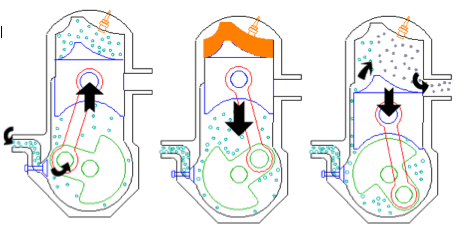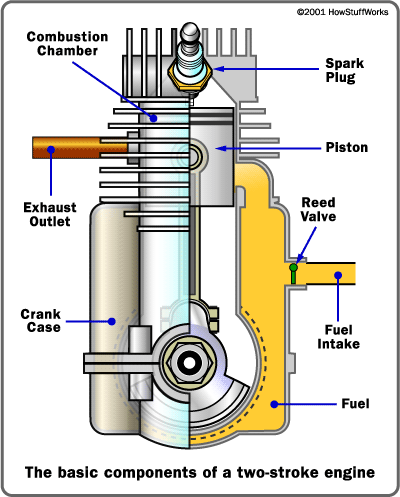| What's Hot! | Products/ Tools | EFI Tuning | Basic Tuning | Advanced Tuning | Chassis Tuning | Advertise with us |
Two Stroke Engines
How a two stroke engine works
Contributed By: Spencer C.
In the advent of the internal combustion engine, two stroke engines are one of the most simple. The only necessary moving parts are the crank shaft, the piston, and a few other odds and ends. Since the valves on a two stroke are static, meaning that they do not move, the inlet and the exhaust are timed by the position of the piston inside of the cylinder. Using the term valves is a misdemeanor, since they are merely holes placed in a way for the engine to operate correctly. I will refer to them as ports, and reserve the word valve for the one way inlet inside of the crank-case.
When I said the inlet and exhaust are timed, what I meant by that is the inlet and exhaust strokes are timed. Hence the names given: two stroke engines uses two strokes, therefore a four stroke engine would use four distinct strokes. In a four stroke engine, the order of operation is as follows: Intake, Compression, Ignition, and Exhaust. In a two stroke engine however, the strokes are called the Power Stroke and the Exchange Stroke. If we think in terms of a four stroke engine, there are two parts to the intake stroke. The method of a two stroke is a simple concept, but it is easiest to see how it operates.
At the beginning of a new stroke, the exhaust and inlet ports are both open. Because of differences in air pressure, new mixture enters the cylinder. Inertia carries the piston upward which first seals the inlet port, since it is located lower, relative to the exhaust port. Once the piston has move far enough up to seal the exhaust port, compression starts to occur. Because the inlet port is connected to the crank-case, a vacuum forms inside of it. The vacuum opens the one way valve and is what empowers the carburetor to function. The mixture flows into the crank-case to replace the vacuum.
In a two stroke engine, the compression ratio is not very high. It is typically a 6:1 ratio, but a more expensive and more efficient two stroke engine might use an 8:1 ratio. It is not uncommon to find four stroke engines with a 12:1 compression ratio. Due to heat caused by compression, gasoline will spontaneously combust at compression ratios as low as 14:1. This is what diesel engine operates on, alone. Using compression ratios of 24:1 are very common in diesel engines, which compress the air until it reaches the right ratio, at which point diesel fuel is injected directly into the cylinder. It also ensures that all the fuel has been expended, allowing for a more complete and efficient burn.
When a two stroke engine reaches the apex of its stroke, a hammer connected to the cam shaft, strikes a piezoelectric crystal, typically quarts, which creates a few thousand volts at only micro amps, powers the spark plug. Most systems however use a magneto system, which provides less resistance. The ignited mixture rapidly expands forcing the piston down. The one way valve inside of the crank-case closes and pressure begins to climb. This will provide the pressure difference the engine requires to push the new mixture into the cylinder when the time comes.
When the piston finally reaches the point where the exhaust port’s seal is broken, the pressure drops significantly. The position of the inlet and exhaust ports relative has to be carefully engineered so that the pressure inside of the cylinder is just less than the pressure inside of the crank-case. If the inlet an exhaust are too close to each other, the new mixture will mix with the exhaust causing inefficiency and if close enough, premature ignition. If, however, if they are too far apart, unused fuel and air will escape unburned, and can cause the muffler’s outlet to flame out, or back-fire. Once the piston finally drops low enough to break the seal on the inlet port, new mixture enters the cylinder and this cycle start over again.

Most two stroke engines will have a choke setting that can be manually adjusted for the current atmospheric settings. When a two stroke starts up, the choke cuts off a large portion of the air supply, causing more vacuum, so more fuel is burned at the start. Once the first stroke passes and the engine starts to speed up, the inlet port will close off more quickly, causing more of a vacuum. On an auto-choke, this vacuum will open the manifold to let more air into the engine and they will also let more air into the engine the more heat that they produce. On a manual choke, however, you have to tune it to the current conditions it is running under.
Also, in a two stroke, you must mix the fuel with the oil. If you were to put oil inside of the crank-case, the piston would flood and due to the viscosity of oil, will blow out the cylinder. Also, adding a hydraulics system makes it that much more complicated, not to mention a reduction in power to run a hydraulics system. This makes the engine much lighter and much less complex.
As a last thought, most two stroke engines are air-cooled, so there is no need for a cooling system. Comparing a four stroke and a two stroke of the same displacement, the two stroke engine is almost twice as powerful because the power stroke occurs every time the piston moves back down instead of every other time. This makes it very effective for tools that need to be lightweight, such as in a weed-whacker, where it is handheld.
Hopefully you understand a little more about the 2-stroke combustions motor.
ATTENTION READER:
If you enjoyed the information and article you just read be sure to check out our newly released book with even more exciting photo's and information:How to Turbocharge and Tune your Engine

Want to know more about your particular Make and Model vehicle? All of these vehicles are covered in the tech, maintenance and repair articles found above. Enginebasics is the wiki or wikipedia of car part, repair, how to and tuning information. Let us be the class 101 for your automotive learning.
| Ford | General Motors GM | Pontiac | Jaguar | Land Rover | Nissan |
| Toyota | Honda | Lexus | Acura | Lotus | Scion |
| Infinity | BMW | Mercedes | Mitsubishi | Ferrari | Maserati |
| Lamborghini | Volks Wagen VW | Saab | Audi | Hyundai | Kia |
| Subaru | Mazda | Chevy | Volvo | Caddilac | Dodge |
| Chrylser | Daewoo | Porsche | Mercury | Freightliner | MG |
Individual Models
| Ford Mustang | Mitsubishi Eclipse | Mitsubishi Evo | Subaru WRX / STI | Dodge Viper | Chevrolet Corvette |
| Nissan Skyline | Honda S2000 | Nissan 350z | Toyota Supra | Chevy Camaro | Lotus Elise Exige |
| Honda Civic | VW Golf | Dodge SRT-4 | Eagle Talon | Acura Integra | BMW M3 |
| Nissan 240sx | Porsche 911 | Acura NSX | Honda Accord | Toyota Camry | Toyota MR2 |
| VW R32 | Dodge Truck | Mazda Rx7 | VW Jetta | Sand Buggy | Nissan Sentra |
For the latest Automotive news and stories visit the websites below |
Our feature Build: An AWD V6 Civic





